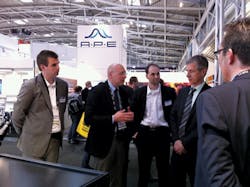Biophotonics was a major theme at this 40th anniversary edition of the biennial mega-event LASER World of Photonics trade fair and World of Photonics Congress (May 13-16, 2013, Munich, Germany), which attracted approximately 27,000 people from 74 countries. Life sciences imaging was the subject of four plenary/keynote sessions, while biophotonics and medical engineering was the focus of one of the event's three photonics forums—that is, industry-focused educational programs presented in the exhibit halls. Further, many exhibitors had displays geared to life sciences. Of course, both the exhibits and the congress had many more interesting offerings than it's possible to describe—or even see in a few short days—but a few highlights give a flavor of the event.
Lihong V. Wang of Washington University in St. Louis (Missouri), a pioneer in photoacoustic tomography, was among the first plenary and keynote speakers; he explained the aspects of this technology that make it so compelling for life sciences. In other plenary sessions, Brian Pogue of Dartmouth College (Hanover, NH) described an application that is exciting for its practical ability to tremendously improve radiation therapy: the use of optical imaging to monitor the administration of radiation in vivo. And Paul French of Imperial College London (England) discussed a range of applications for fluorescence lifetime imaging and metrology.
The official opening plenary talk featured super-resolution microscopy pioneer Stefan Hell of the Max Planck Institute for Biophysical Chemistry (Goettingen, Germany), who reviewed efforts to overcome the diffraction limit (which prevents light from being concentrated at less than 200 nm) and said that while nonlinear (e.g., multiphoton) microscopy has provided a solution to the resulting problem of resolving nanoscale features, actually "nonlinearity is not the best line of thinking" to this end. He said a better way to conceptualize the challenge is in terms of on-off switching of various states, and he then presented the RESOLFT (REversible Saturable OpticaL Fluorescence Transitions) approach, which he said enables imaging at molecular and even atomic scales. An advanced implementation of this method involves parallelization (that is, the use of arrays) to speed scanning.
Excitement in the exhibits
Afterward, Hell made a number of visits to the Biophotonics Research Program stand in the exhibit hall, where the first commercial instrument based on RESOLFT, by Abberior Instruments (Goettingen, Germany), was on display. As in past years, the Biophotonics Research Program—which is funded by both industry members and Germany's Federal Ministry of Education and Research—showcased interesting technologies and applications that result from goal-oriented industry and academic collaborations. Another of the booth's displays featured iTheraMedical's (Munich, Germany) newly commercialized instruments for multispectral optoacoustic tomography (MSOT). For video interviews discussing these technologies, please see http://bcove.me/n6x0k4vy.
TRUMPF Scientific Lasers (Munich, Germany) had on display an attosecond laser as a proof of concept, and NKT Photonics (Birkerød, Denmark) demonstrated what it calls "the world's first tunable deep-UV supercontinuum-powered light source." To address bioimaging in deep UV (intrinsic fluorescence from proteins, for instance) NKT's new SuperK EXTEND-UV provides tunable light from 270 to 400 nm with 10 to 100 μW power levels—and fast pulses (to 20 ps with variable megahertz-range repetition)—at a fraction of the cost of large solid-state lasers, and with the robustness and reliability of fiber lasers. It also compares favorably with UV LEDs.
Qioptiq (Goettingen, Germany) showcased its miniaturized iFlex UV-VIS-NIR laser family and mag-x system125 microscope, offering large field of view and high numerical aperature, among other innovations. Queensgate Instruments (Cambridge, England) introduced a range of new nanopositioning products, including the NPC-D-5110DS digital controller, which enables stages and actuators to be swapped without requiring downtime for recalibration.
The next LASER World of Photonics and World of Photonics Congress will take place June 21-25, 2015, in Munich. Visit the event website for more information: www.world-of-photonics.net/en/laser/start.


